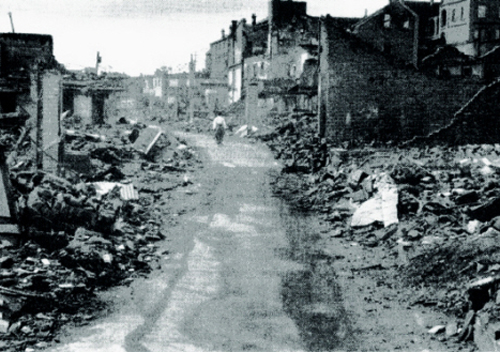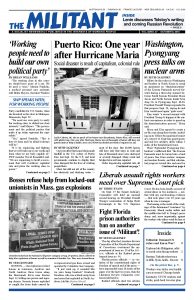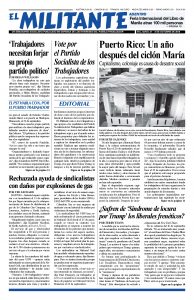
Efforts by the rulers in Washington and leaders in North Korea to reach an agreement on “denuclearization” of the Korean Peninsula moved forward during a three-day summit between South Korean President Moon Jae-in and North Korean leader Kim Jong Un in Pyongyang Sept. 18-20. President Donald Trump responded to that progress Sept. 24, saying he and Kim would meet again “quite soon.”
Kim wants “a second summit with President Trump to happen at the earliest convenience in order to speed up the denuclearization process,” Moon said.
Moon and Kim agreed to create a no-fly zone along their border, including on its Yellow Sea maritime boundary; remove 11 front-line guard posts; and end live artillery drills within 3 miles of the demilitarized zone.
Their “September Pyongyang Declaration” reaffirmed that “the Korean Peninsula must be turned into a land of peace free from nuclear weapons and nuclear threats, and that substantial progress toward this end must be made in a prompt manner.”
The government of the Democratic People’s Republic of Korea offered to permanently dismantle its missile testing site and launch platform in the northwestern town of Tongchang-ri, and to allow outside experts to observe. The site was used to test-fire intercontinental ballistic missiles last year that had the capacity to reach the U.S.
Kim added that Pyongyang would permanently dismantle its Yongbyon nuclear complex, its main site for production of nuclear weapons, if Washington “takes corresponding measures” in the “spirit” of the agreement Kim and Trump reached in Singapore in June. According to Moon, the “measure” the North Koreans want is a U.S. declaration officially ending the 1950-53 Korean War.
Declaring the war finally over would not mean the withdrawal of the 28,500 U.S. troops stationed in the South, Moon said, but would be a meaningful symbolic step.
After the summit ended, State Department spokesperson Heather Nauert said that all three governments have a “shared understanding” that U.S. and International Atomic Energy inspectors will be involved in the shutdown of the Yongbyon complex.
North and South are ‘one people’
While in Pyongyang, Moon spoke to a crowd of 150,000 people, saying, “We have lived together for 5,000 years and apart for 70. We must live together as one people.”
The U.S. government — with the agreement of Moscow — trampled on the Korean people’s national sovereignty and divided Korea into North and South in 1945, after the defeat of Tokyo in the second imperialist World War. In the North, working people carried out a deep-going agrarian reform, expropriated the landlords and capitalists, and carried out other social measures in their interests. But in the South the U.S. military put in place the Syngman Rhee dictatorship that brutally put down protests by workers and farmers.
Millions were killed during the Korean War, which broke out in 1950. In a shock to the U.S. rulers, Korean workers and farmers, with the help of Chinese volunteers, fought the U.S.-led invasion army to a stalemate, dealing U.S. imperialism its first ever military defeat.
But while Washington was forced to agree to an armistice, it refused to sign a peace treaty to formally end the war. Until 1991 the U.S. government openly kept tactical nuclear weapons on South Korean territory. U.S. nuclear-armed submarines continue to prowl the Pacific to this day.
Kim and Moon also agreed to hold more reunification meetings for families that have been divided for over 70 years since the peninsula was split in two. They also agreed to pave the way for video family meetings. Currently there is not even mail service between North and South.
Secretary of State Michael Pompeo said that he has invited North Korean Foreign Minister Ri Yong Ho to meet in New York during the opening sessions of the United Nations General Assembly. Referring to the proposals coming out of the North-South summit, Pompeo said, “On the basis of these important commitments, the United States is prepared to engage immediately in negotiations to transform U.S.-DPRK relations.”
The editors of the Washington Post, like much of the rest of the liberal capitalist media that see all questions through the prism of their furious “resistance” to the Trump presidency, tried to downplay developments in Korea. Despite “some significant steps to reduce tensions and the risk of war,” they wrote Sept. 22, the latest moves offer “no real progress in the matter of most import to the United States: the dismantlement of North Korea’s arsenal of nuclear weapons.”
“We demand the U.S. government sign a peace treaty and make permanent the halt to the provocative annual war games it has carried out with Seoul,” Róger Calero, Socialist Workers Party candidate for governor of New York, said the same day. “Reaching an agreement with the Democratic People’s Republic of Korea on a Korea free of nuclear weapons is in the interest of all working people, there and around the world.”

